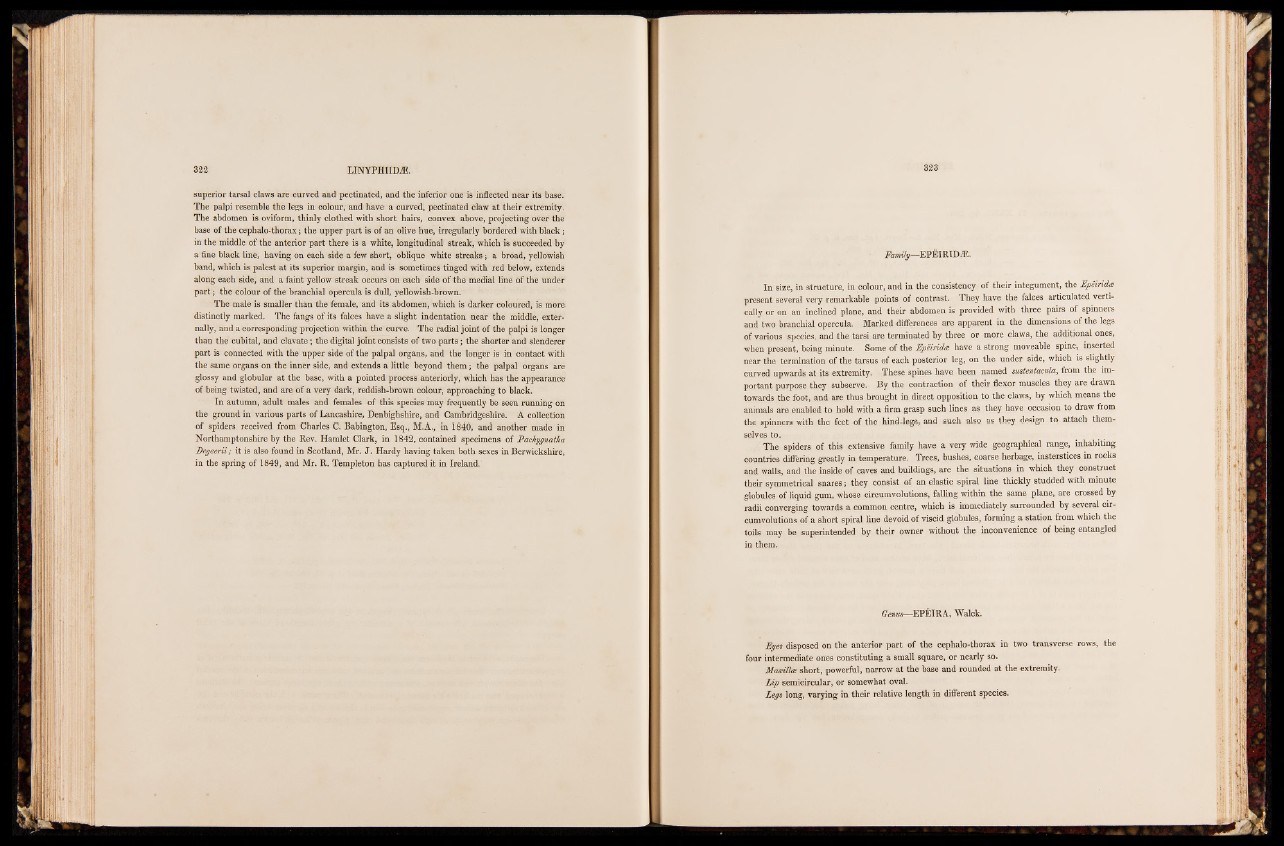
superior tarsal claws are curved and pectinated, and the inferior one is inflected near its base.
The palpi resemble the legs in colour, and have a curved, pectinated claw at their extremity.
The abdomen is oviform, thinly clothed with short hairs, convex above, projecting over the
base of the cephalo-thorax; the upper part is of an olive hue, irregularly bordered with black;
in the middle o f the anterior part there is a white, longitudinal streak, which is succeeded by
a fine black line, having on each side a few short, oblique white streaks; a broad, yellowish
band, which is palest at its superior margin, and is sometimes tinged with red below, extends
along each side, and a faint yellow streak occurs on each side o f the medial line of the under
part; the colour of the branchial opercula is dull, yellowish-brown.
The male is smaller than the female, and its abdomen, which is darker coloured, is more
distinctly marked. The fangs of its falces have a slight indentation near the middle, externally,
and a corresponding projection within the curve. The radial joint o f the palpi is longer
than the cubital, and clavate; the digital joint consists of two parts; the shorter and slenderer
part is connected with the upper side of the palpal organs, and the longer is in contact with
the same organs on the inner side, and extends a little beyond them; the palpal organs are
glossy and globular at the base, with a pointed process anteriorly, which has the appearance
of being twisted, and ares of a very dark, reddish-brown colour, approaching to black.
In autumn, adult males and females of this species may frequently be seen running on
the ground in various parts of Lancashire, Denbighshire, and Cambridgeshire. A collection
of spiders received from Charles C. Babington, Esq., M.A., in 1840, and another made in
Northamptonshire by the Rev. Hamlet Clark, in 1842, contained specimens of Pachygnatha
De yee rii; it is also found in Scotland, Mr. J. Hardy having taken both sexes in Berwickshire,
in the spring of 1849, and Mr. R. Templeton has captured it in Ireland.
Family—EPËIRIDÆ.
In size, in structure, in colour, and in the consistency of their integument, the E peirida
present several very remarkable points of contrast. They have the falces articulated vertically
or on an inclined plane, and their abdomen is provided with three pairs of spinners
and two branchial opercula. Marked differences are apparent in the dimensions of the legs
o f various species, and the tarsi are terminated by three or more claws, the additional ones,
when present, being minute. Some of the Epeiridee have a strong moveable spine, inserted
near the termination of the tarsus of each posterior leg, on the under side, which is slightly
curved upwards at its extremity. These spines have been named sustentacula^ from the important
purpose they subserve. By the contraction of their flexor muscles they are drawn
towards the foot, and are thus brought in direct opposition to the claws, by which means the
animals are enabled to hold with a firm grasp such lines as they have occasion to draw from
the spinners with the feet of the hind-legs, and such also as they design to attach themselves
to.
The spiders of this extensive family have a very wide geographical range, inhabiting
countries differing greatly in temperature. Trees, bushes, coarse herbage, insterstices in rocks
and walls, and the inside of caves and buildings, are the situations in which they construct
their symmetrical snares; they consist of an elastic spiral line thickly studded with minute
globules of liquid gum, whose circumvolutions, falling within the same plane, are crossed by
radii converging towards a common centre, which is immediately surrounded by several circumvolutions
of a short spiral line devoid of viscid globules, forming a station from which the
toils may be superintended by their owner without the inconvenience of being entangled
in them.
Genus—EPËIRA, Walck.
Eyes disposed on the anterior part o f the cephalo-thorax in two transverse rows, the
four intermediate ones constituting a small square, or nearly so.
Maæilloe short, powerful, narrow at the base and rounded at the extremity.
L ip semicircular, or somewhat oval.
Legs long, varying in their relative length in different species.